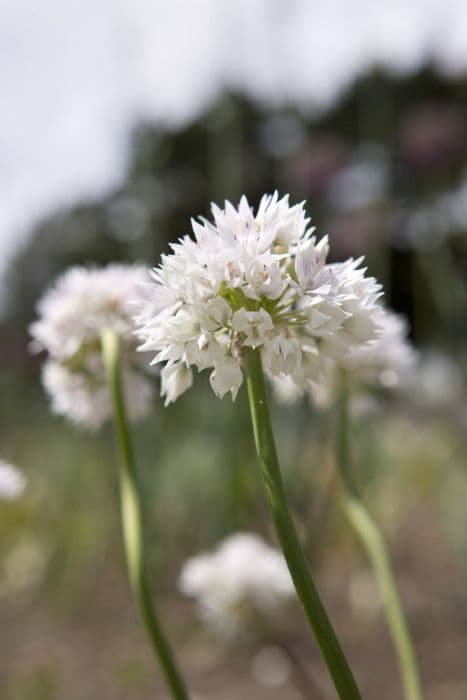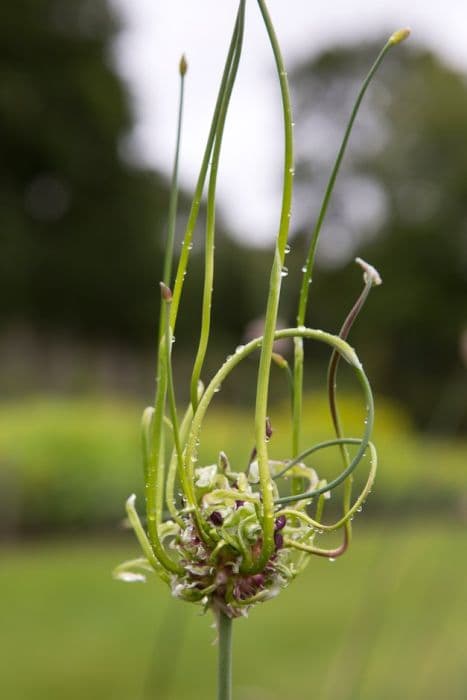Sarawschan Onion Allium sarawschanicum

ABOUT
Allium sarawschanicum, commonly known as the ornamental onion, presents itself as a graceful perennial that adds a touch of whimsy to any garden setting. The plant boasts beautiful globular flower heads comprised of numerous star-shaped flowers that seem to float atop slender, leafless stems. The blossoms are typically purple, adding a soothing splash of color that could blend well in various garden palettes or stand out as a featured element in a planting scheme. The foliage of the ornamental onion is also noteworthy, with its strappy, grass-like leaves that create a nest at the base of the plant. These leaves often emit a distinct onion-like fragrance when crushed or bruised, lending to the plant's name. The texture of both leaves and flowers adds visual interest, presenting a contrast with smoother foliage or flower types in the garden. The ornamental onion's structure and form result in a plant that can serve a functional role as well, acting as a vertical accent or a focal point in flower beds and borders. Its visual appeal is not only limited to daytime; as the dusk falls, the spherical flower heads can catch the fading light, giving a soft, almost ethereal glow to a night garden. As a hardy plant, the ornamental onion generally has a period where it goes dormant, with the above-ground parts dying back, only to return with vigor in the appropriate season. This resilient adaptability means that once established, it can become a recurring highlight in the landscape, with minimal maintenance required.
About this plant
 Names
NamesFamily
Amaryllidaceae
Synonyms
Sarawschan Onion
Common names
Allium jacquemontii Regel, Allium sarawschanicum Regel.
 Toxicity
ToxicityTo humans
Allium sarawschanicum, commonly known as garlic, is generally not toxic to humans when consumed in typical culinary amounts. However, in large quantities or in certain sensitive individuals, it may lead to gastrointestinal irritation or discomfort. If an unusually large amount is ingested, it could potentially cause more severe issues such as hemolytic anemia, but this is rare. Most people can enjoy garlic without adverse effects.
To pets
Garlic is toxic to pets, specifically dogs, and cats. When a pet ingests garlic, it can cause damage to their red blood cells, leading to hemolytic anemia. Symptoms of poisoning may include lethargy, pale gums, rapid breathing, weakness, jaundice, vomiting, diarrhea, and in severe cases, it can even be fatal. Prompt veterinary care is essential if a pet has ingested garlic.
 Characteristics
CharacteristicsLife cycle
Perennials
Foliage type
Deciduous
Color of leaves
Green
Flower color
Varies
Height
1-2 feet (30-60 cm)
Spread
6-12 inches (15-30 cm)
Plant type
Bulb
Hardiness zones
5
Native area
Central Asia
Benefits
 General Benefits
General Benefits- Culinary Uses: Allium sarawschanicum, commonly known as Central Asian onion, can be used in cooking for its flavorful bulbs and edible stems, which can enhance a variety of dishes.
- Aesthetic Appeal: With its attractive flowers, the Central Asian onion can be used as an ornamental plant to enhance the beauty of gardens and landscapes.
- Pollinator Attraction: The flowers of Central Asian onion are known to attract bees and other pollinators, supporting local ecosystems.
- Ease of Care: This species is generally low-maintenance, requiring minimal care once established, making it suitable for beginner gardeners.
- Drought Resistance: Central Asian onion is adapted to survive with limited water, making it ideal for xeriscaping and drought-prone areas.
- Culinary Herb: Its leaves are sometimes used as a herb, providing a subtle flavoring agent in traditional dishes.
 Medical Properties
Medical Properties- This plant is not used for medical purposes.
 Air-purifying Qualities
Air-purifying QualitiesThis plant is not specifically known for air purifying qualities.
 Other Uses
Other Uses- Allium sarawschanicum, commonly known as Sarawschan onion, can be used as a natural dye for textiles, providing a range of colors depending on the mordant used in the process.
- The plant's sturdy stems can be utilized in floral arrangements, adding an exotic element to bouquets and centerpieces due to its unique bloom structure.
- Gardeners may plant Sarawschan onion as a companion plant to deter pests from more vulnerable crops, owing to its strong scent and potential repellent properties.
- Intrigued by its ornamental appearance, artists and photographers may use the Sarawschan onion as a subject in their work to capture the intricate patterns of its blossoms.
- Culinary experimenters might use the dried seed heads of Sarawschan onion to infuse oils or vinegars with a subtle flavor and decorative appeal.
- The plant can be incorporated into educational programs and botanical studies to demonstrate biodiversity and pollination strategies in the Allium genus.
- Ecologists can use Sarawschan onion in habitat restoration projects, as it can contribute to the establishment of a native flora that supports local wildlife.
- Garden designers may use Sarawschan onion as a natural border or edging in landscape designs, exploiting both its aesthetic and enduring qualities.
- The crushed leaves of Sarawschan onion may serve as a natural rust preventative for garden tools when rubbed onto the metal surfaces, due to the presence of certain sulfurous compounds.
- Craft enthusiasts might dry and varnish the attractive seed heads of Sarawschan onion to create natural ornaments for decoration or as part of homemade wreaths.
Interesting Facts
 Feng Shui
Feng ShuiThe Giant Onion is not used in Feng Shui practice.
 Zodiac Sign Compitability
Zodiac Sign CompitabilityThe Giant Onion is not used in astrology practice.
 Plant Symbolism
Plant Symbolism- Resilience: Alliums in general symbolize resilience and endurance due to their hardy nature and ability to grow in harsh conditions.
- Unity: The round shape of the allium flower head represents unity, as it is made up of many small flowers forming a complete sphere.
- Strength: The tall and straight stems of the allium plant suggest strength and steadfastness, often inspiring gardeners and nature enthusiasts alike.
- Good Fortune: In some cultures, alliums are thought to bring good luck and are planted with this intention.
- Protection: Historically, alliums have been used in various cultures to ward off evil spirits and protect against negative influences, as they were believed to have strong medicinal and magical properties.
 Water
WaterThe Giant Onion, Allium sarawschanicum, prefers to have consistently moist soil, but it is also important to avoid overwatering to prevent rot. During the growing season in spring and early summer, water it with about 1 gallon per week, depending on weather conditions—less if there's significant rainfall, and potentially more during drier, hotter weeks. Decrease watering frequency once the flowers have faded and the leaves begin to yellow and die back, typically after blooming has finished. During dormancy in late summer and fall, water sparingly, only to prevent the soil from completely drying out. It is best to water deeply and less frequently, to encourage the roots to grow deeper into the soil.
 Light
LightThe Giant Onion thrives best in full sun conditions where it can receive at least 6 to 8 hours of direct sunlight per day. It will grow well in a spot in the garden that is exposed to the full sun. Partial shade is tolerated, but blooming may not be as prolific. Ensure that it's not shaded by larger plants as this could affect its growth and flowering.
 Temperature
TemperatureThe Giant Onion prefers a temperature range of 55°F to 75°F but can tolerate temperatures as low as 20°F and as high as 90°F for short periods. The ideal growing conditions are cool to mild temperatures, avoiding extended periods of extreme heat or cold. They are cold-hardy and can survive winter temperatures down to at least zone 4, making them suitable for many temperate climates.
 Pruning
PruningPruning the Giant Onion typically involves deadheading spent flowers to tidy the plant and prevent self-seeding if desired. Pruning is not usually necessary for plant health but can be done after flowering when the flower stalks and leaves begin to wither. Prune back foliage in late summer or early fall as it starts to die back naturally. It is not necessary to prune this plant extensively; simply remove spent flower stalks and yellowing leaves.
 Cleaning
CleaningAs needed
 Soil
SoilThe best soil mix for Persian shallot, which is the most common name for Allium sarawschanicum, is a well-draining, loamy soil that is rich in organic matter. It should have a pH level ranging from 6.0 to 7.0. A mix with added compost or well-rotted manure can help supply nutrients.
 Repotting
RepottingPersian shallot generally does not need frequent repotting. It can be repotted every 3-4 years, or when the clumps become overcrowded. It's best to divide and repot these plants in the autumn months.
 Humidity & Misting
Humidity & MistingPersian shallot prefers a dry to moderate humidity level. As a bulbous plant, it is tolerant of low humidity and does not require high humidity to thrive.
 Suitable locations
Suitable locationsIndoor
Ensure bright light, well-drained soil, and cooler temperatures for Persian shallot.
Outdoor
Plant in sunny spot with well-draining soil and space bulbs apart.
Hardiness zone
5-8 USDA
 Life cycle
Life cycleAllium sarawschanicum, commonly known as the sarawschan onion, typically starts its life cycle from seed, which when sown, will germinate in moist, well-draining soil. Following germination, it develops a root system and foliage in the form of long, strappy leaves, characteristic of many Allium species. As it matures, the plant enters a vegetative stage where it focuses on growth and energy accumulation through photosynthesis. After a period of vegetative growth, the plant will produce a flowering stem topped with a spherical cluster of star-shaped flowers, known for attracting pollinators if grown outdoors. Once pollination occurs, the plant will produce seeds that will mature, then be dispersed naturally or collected for propagation. Finally, after seeding, the plant will senesce and die back, although Allium sarawschanicum is a perennial species, so its underground structures, like bulbs, will survive to send up new growth in the next growing season.
 Propogation
PropogationPropogation time
Spring
Allium sarawschanicum, commonly known as Giant Onion, is typically propagated by seed or more effectively, by dividing the plant's bulb clusters. The most popular method of propagation is through division, which is best done in the autumn after the leaves have died back. To propagate Giant Onion by division, carefully dig up the bulbs, trying not to damage the roots or bulb scales, and gently separate the individual bulbs from the main clump. Each bulb should have a portion of the basal plate, which is necessary for the development of roots and shoots. Replant the bulbs at the same depth they were growing previously, usually about 2 to 3 inches deep (5 to 7.5 centimeters), and spaced approximately 8 to 10 inches apart (20 to 25 centimeters). Water the newly planted bulbs thoroughly to help establish them. This method allows for the quick increase of your Allium plants while maintaining the genetic characteristics of the parent plant.








